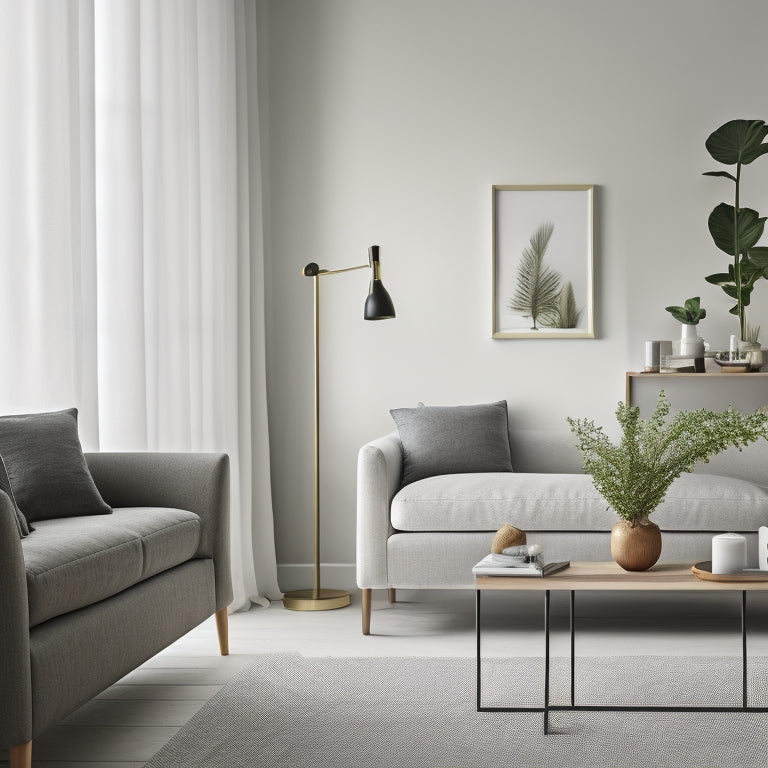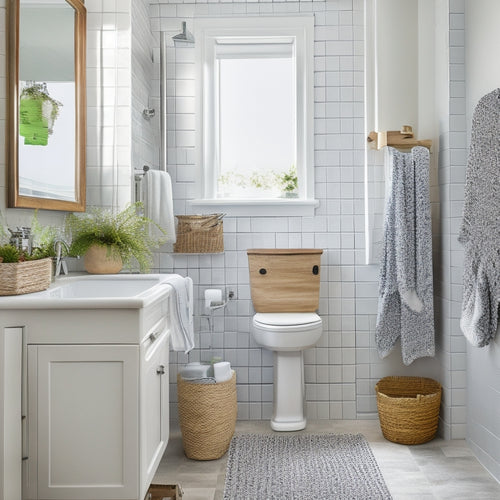
What's the Secret to a Clutter-Free Small Space?
Share
You're craving a clutter-free small space, but don't know where to start. Begin by purging items you no longer need, then optimize your furniture layout to create a sense of flow. Make the most of your walls by utilizing vertical storage spaces, and choose multifunctional pieces that serve more than one purpose. Designate a home for each item, and implement a maintenance routine to keep clutter at bay. By following these simple strategies, you'll be well on your way to a peaceful, organized space. And, there are even more clever secrets to explore that'll help you maximize your space's full potential.
Key Takeaways
• Purge unnecessary items and designate a home for each remaining item to maintain a clutter-free space.
• Optimize furniture layout by maximizing space, considering scale and traffic flow, and utilizing vertical storage.
• Implement a maintenance routine with daily habits and regular decluttering sessions to prevent clutter buildup.
• Utilize multi-functional furniture solutions and storage containers to maximize space efficiency.
• Create a personalized categorization system and labeling to ensure easy access and maintain organization.
Purge Items You No Longer Need
Start by gathering three boxes or bins labeled 'keep,' 'donate/sell,' and 'discard' to categorize items as you sort through your belongings. This simple step will help you tackle the challenging task of decluttering your small space.
As you sort, be honest with yourself about each item. Ask if you've used it in the past year, if it still serves a purpose, or if it brings you joy. Be cautious of emotional attachment, which can make it difficult to let go of items that no longer serve you. Remember, the goal is to create a clutter-free space that sparks joy and efficiency.
Decision fatigue can set in quickly when faced with a plethora of items to sort through. To combat this, focus on one area or category of items at a time. For example, start with your closet or kitchen utensils. By breaking it down into smaller tasks, you'll make the process less overwhelming and more manageable.
As you sort, be ruthless – if you don't need it, consider donating or selling it. By the end of this process, you'll be left with only the items that bring value and purpose to your life.
Optimize Your Furniture Layout
Now that you've purged your unwanted items, it's time to think about how you'll arrange the furniture you're keeping.
You'll want to create a layout that makes the most of your small space, considering the flow and functionality of each room.
Effective Space Planning
You'll need to measure your space and furniture carefully to create a functional layout that works for you. This is where effective space planning becomes important. It's essential to take into account the scale of your furniture and the room itself. A large piece of furniture in a small room can make the space feel cramped, while a small piece in a large room can make it feel empty.
To optimize your furniture layout, keep the following strategies in mind:
-
Scale considerations: Choose furniture that's proportional to the room and each other. A large sectional sofa might be comfortable, but it mightn't fit in a small living room.
-
Zoning strategies: Divide your space into zones, such as a sleeping area, workspace, or entertainment zone. This will help you determine the best layout for each area.
-
Traffic flow: Leave enough space between furniture for easy movement. You don't want to have to squeeze between the couch and coffee table every time you want to grab a snack.
Flow and Functionality
Flow and Functionality
By applying the principles of space planning, you can create a furniture layout that not only looks great but also facilitates a smooth flow of traffic and supports your daily activities. A well-designed layout guarantees that you can move efficiently throughout your space, reducing clutter and increasing productivity.
To achieve Visual Harmony, consider the following guidelines for your furniture layout:
| Zone | Purpose | Layout Tips |
|---|---|---|
| Living | Relaxation | Place furniture in a conversational circle, leaving enough space for Mindful Movement |
| Working | Productivity | Position your desk near a natural light source, with minimal distractions |
| Sleeping | Rest | Create a cozy nook with a comfortable bed, minimal furniture, and soothing colors |
| Circulation | Traffic flow | Leave enough space between furniture for easy navigation, avoiding narrow pathways |
Utilize Vertical Storage Spaces
Take advantage of your small space's often-overlooked vertical storage spaces, such as the area above your furniture or the back of a door, to maximize your storage capacity. By utilizing these areas, you'll create a more clutter-free environment and make the most of your space.
Here are some ways to make the most of your vertical storage spaces:
-
Install wall shelves to store books, decorative items, or kitchenware, keeping them out of the way but still accessible.
-
Use ceiling hooks to hang bikes, baskets, or pots and pans, freeing up floor and counter space.
-
Attach a storage rack or pegboard to the back of a door to store cleaning supplies, accessories, or bags, keeping them organized and within reach.
Choose Multifunctional Pieces
When furnishing your small space, it's crucial to choose pieces that serve multiple purposes.
You'll want to look for space-saving designs that can adapt to your needs, like a storage ottoman that doubles as a coffee table.
Space Saving Designs
You'll often find that choosing multifunctional pieces is key to maximizing space in a small area, as they eliminate the need for separate items that serve only one purpose. By selecting space-saving designs, you can create a more organized and clutter-free environment.
Here are some ideas to get you started:
-
Modular shelves: These versatile shelves can be easily rearranged or expanded as your storage needs change. They're perfect for small spaces, as they can be configured to fit snugly into corners or against walls.
-
Compact modules: Look for compact modules that combine multiple functions in one unit, such as a storage ottoman with a built-in tray or a desk with built-in shelving.
-
Retractable or foldable pieces: Consider using retractable or foldable pieces, like a foldable desk or a retractable drying rack, to save space when not in use.
Double Duty Furniture
Opt for a sofa bed that moonlights as a comfortable seating area by day and a cozy sleeping space by night, killing two birds with one stone in your compact abode. By choosing multifunctional pieces, you'll maximize your space without sacrificing functionality or style.
Consider a desk with built-in storage, a coffee table with lift-top storage, or an ottoman that doubles as a storage unit. These space savers will help keep your clutter at bay while providing you with the functionality you need.
When selecting double duty furniture, think about your lifestyle and what you need most. Do you work from home? Invest in a murphy desk that folds up against the wall when not in use. Do you love to entertain? Look for a coffee table with built-in wine storage or a bar.
Designate a Home for Each Item
Assigning a designated spot for each item helps maintain order and prevents clutter from building up in the first place. By doing so, you'll be able to find what you need quickly and easily, and you'll be less likely to lose or misplace things.
To make this system work, you'll need to create a personalized categorization system that makes sense to you.
Here are some tips to get you started:
-
Use labeling systems: Labels can help you identify what's inside a container or on a shelf, making it easier to find what you need.
-
Categorize similar items together: Grouping similar items, such as cleaning supplies or kitchen utensils, can help you see what you have and where it belongs.
-
Store items by frequency of use: Store items you use frequently in easy-to-access locations, and less frequently used items in harder-to-reach areas.
Implement a Maintenance Routine
Once you've designated a home for each item, it's time to create a routine to maintain your newly organized space, ensuring that clutter doesn't creep back in. This maintenance routine will help you stay on top of clutter and keep your space organized.
Start by establishing daily habits that promote tidiness, such as putting away items after use, wiping down surfaces, and making your bed. These small actions may seem insignificant, but they'll make a big difference in the long run.
In addition to daily habits, consider implementing a seasonal refresh. Set aside a few hours each season to reassess your space, get rid of items no longer needed, and reorganize areas that have become cluttered. This will help you stay on track and prevent clutter from building up over time.
Make the Most of Hidden Spaces
To maximize the potential of your small space, utilize hidden areas like under-bed storage, hollowed-out books with secret compartments, or decorative storage ottomans to stash items that you don't frequently use. This will help keep your living area clutter-free and organized.
By making the most of these hidden spaces, you'll be able to store items that you need but don't use regularly, such as out-of-season clothing or infrequently used kitchen gadgets.
Here are some ideas to get you started:
- Install secret shelves behind mirrors or paintings to store valuable or sensitive items
- Use hidden compartments in furniture, such as storage beds or coffee tables, to stash items like linens or cleaning supplies
- Create a hidden storage area in a closet or cabinet by installing a sliding panel or secret drawer
Frequently Asked Questions
How Do I Decide What to Keep and What to Donate or Discard?
When deciding what to keep, ask yourself if it holds sentimental value or emotional attachment. If not, consider letting it go. If yes, evaluate its usefulness and allocate a designated space, ensuring it sparks joy and serves a purpose.
Can a Clutter-Free Small Space Still Feel Cozy and Inviting?
You stroll into a medieval great hall, minus the clutter, and ask: can a minimalist space still be cozy? Absolutely! By mastering texture balance and moody lighting, you'll craft an intimate, inviting atmosphere that whispers "stay a while" without the visual noise.
Are There Any Affordable Storage Solutions for Small Spaces?
You'll find affordable storage solutions by using stackable shelves to maximize vertical space and hanging organizers to utilize door or wall areas, creating a clutter-free zone without breaking the bank.
How Often Should I Reassess My Belongings to Maintain a Clutter-Free Space?
You set a seasonal purge schedule, and you commit to it; you form habits like daily tidying and weekly reviews to maintain a clutter-free space, ensuring your belongings align with your evolving needs and wants.
Can a Clutter-Free Small Space Be Achieved With a Limited Budget?
You can achieve a clutter-free small space on a limited budget by adopting frugal habits, repurposing items, and tackling DIY projects, such as upcycling furniture and creating storage solutions that fit your needs and budget.
Related Posts
-

Optimize Your Small Home Office With Smart Storage
You can instantly boost your productivity and reduce stress by optimizing your small home office with smart storage s...
-

Bathroom Storage Hacks for Small Spaces Revealed
You're about to discover the ultimate bathroom storage hacks for your small space! Start by maximizing your vertical ...

